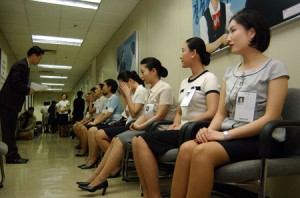- California Assembly OKs highest minimum wage in nation
- S. Korea unveils first graphic cigarette warnings
- US joins with South Korea, Japan in bid to deter North Korea
- LPGA golfer Chun In-gee finally back in action
- S. Korea won’t be top seed in final World Cup qualification round
- US men’s soccer misses 2nd straight Olympics
- US back on track in qualifying with 4-0 win over Guatemala
- High-intensity workout injuries spawn cottage industry
- CDC expands range of Zika mosquitoes into parts of Northeast
- Who knew? ‘The Walking Dead’ is helping families connect
Many S. Korean companies shun ‘older’ applicants as young as 28
Four out of 10 companies restrict the age of recruits, a survey shows.
Saramin, an online recruiting service, found that 166 corporations 38.6 percent said they used an age restriction to filter applicants.
For male applicants, the largest percentage of firms cited the maximum age as 30 (25 percent), followed by 33 (20.3 percent) and 32 (17.2 percent).
For female applicants, the largest percentage of companies cited the maximum age as 26 (21.9 percent), followed by 30 (18.8 percent), 28 (12.5 percent) and 32 (12.5 percent).
On why they placed restrictions, where respondents were able to provide multiple answers, 37.5 percent said “because it could affect the hierarchy of the organization,” followed by “because other employees feel uncomfortable” (34.4 percent), “because it seems like they won’t be able to properly adjust to the organizational culture” (32.8 percent) and “because they will demand better working conditions” (21.9 percent).
More than half the companies (53.1 percent) with age restrictions said they had eliminated applicants solely on age.
They regarded the appropriate age of new recruits to be 29 for men and 27 for women.

















thomas
July 7, 2015 at 6:12 PM
Companies practice of discriminating against “older” applicants is shortsighted. First, by self limiting the company to a single demographic, in this case, young adults, is shortsighted and obtuse. The company becomes less dynamic and thus unable to connect with a broader customer base. This leads to loss in profits because of their inability and/or unwillingness to expand their target audience/market. Second, the internal culture becomes more acidic and unlikely tolerate or embrace change. This mindset ultimately becomes public perception of the company. Third, this practice works against one team, one company mentality for the existing employees. For instance, what employee would want to fully dedicate their career to a company who constantly flushes out what it perceives as outdated/old.